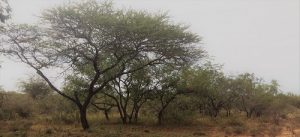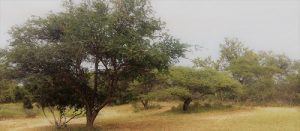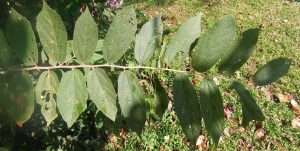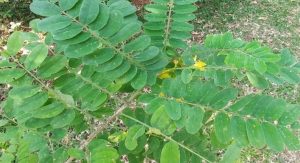Nature Natter: ID Trees
• 3 May 2017
In this blog post John Gear explains how to identify trees
Having written about some trees that you might like to plant around your house, it struck me that there may be owners, who love trees, but are not familiar with the incredible variety of trees that we are lucky to have on Zandspruit and also who have little or no clue about the identity of each.
ID a Tree
There is no way in a brief blog that I am going to make you an expert no matter your passion or intellect. Tree expertise comes from continuous exposure over time and in many of us it is never achieved despite intellect and passion. However the thrill and joy of trying and occasionally succeeding in ID-ing a tree is a feeling all should have at least once in their lives. Therefore my purpose in this blog is to make you want to try for that elusive first ID or if you are already an enthusiastic tree spotter to encourage you to go the next level. So we shall start from basics.

The Basics
Many of you have embraced the mammal and bird life of Zandspruit. I want you to go back to your early birding experiences. Before you started ID-ing birds you knew that they came in various sizes, had beaks, heads, eyes, bodies and tails. They occurred in different places but you had little idea how to put these characteristics to good use. Perhaps you bought a bird Book or went to a Beginners’ Course in Bird ID. You learned to look closely at these key parts of bird anatomy and started describing what you saw.
Bird ID features
• Size: this is a critical feature in bird ID and instead of big and small you learnt to be more precise in description. Twice the size of a farmyard chicken, half the size of a chicken, smaller than a chicken’s chick.
• Beaks: shape, size and colour were shown to be critical in ID-ing. Insectivorous birds have strong straight sharp beaks. Seed eaters have heavier beaks. Specialized beaks are seen in Kingfishers, Woodpeckers and Eagles, to name but a few.
• Legs: length of leg, leg-feathers and colour need to be noted. One way to differentiate the variety of Egrets is based on leg colour. Eagles have feathered “pantalooned” legs.
• Body: plumage colour must be precisely described and you learned that many male and female birds of the same species differ markedly in colour; males are bright and showy, females are usually drab. A further refinement: many males are drab when out of breeding season.
• Habitat: is bird in forest, desert, in water-rich surroundings, at coast or open ocean?
Observe the Tree
Each of these key discriminators helped you reduce the number of possibilities dramatically from the 500-600 possible birds in our area. When you combined all these discriminators you had reduced the possibilities to 20 birds if you were unlucky and 10 or fewer if you were lucky. Tree ID-ing is based on exactly the same approach; making accurate observations and combining them to aid your detective work.
Let’s start with what we know about trees as lay people.
All trees have the following key features that can help you in your attempt to ID:

Habitat
Very few indigenous trees grow in every Province in RSA and many confine themselves to particular habitats. These habitats overlap provincial boundaries which are artificial and man-made. Key habitats include:
o Coastal belt
o Mountains with high rainfall
o Deserts with low rainfall
o Frost-free low-lying areas (like the Lowveld where we live)
o Riverbanks
Geology
Within these habitats there are important sub-divisions often influenced by soil characteristics; some examples are:
o Clay-rich soils
o High water-table soils
o Sandy soils
o Shallow or deep soils
o Stony ground
o Alkaline limestone soils
So your first step in trying to ID a tree is to describe where you are and the precise characteristics of the tree’s location. Yes, you may be in Hoedspruit area, but are you on the Blyde River Bank or a stony ridge exposed to baking sun and with seemingly little or no moisture.
Moving on to the tree itself; very simply trees are made up of woody parts, sap, leaves, flowers and fruits. Each of these can be observed more accurately:
Woody parts
o Trunk: This is the main stem of the tree; some trees have a single trunk while others are multi-stemmed. This feature may help a little in your ID challenges.
o Bark: bark is often difficult to describe and it varies in character as the tree ages. However there is one local tree that has an unmistakable bark: the sulphur yellow bark of the Fever Tree (Acacia xanthophloea – sadly it is now called Vachellia xanthophloea because Australia claimed “Acacia” as the name for the huge variety of their trees and our “Acacias” do not form a part of that large Australian Genus). For this note I shall continue to refer to our African “acacias” as Acacias and you will see in most books both the new and old names are given. As you become more adventurous and skilled at observing bark you may start to identify members of the Corkwood (Commiphora) genus which have flaky, often greenish, bark. We have a number of species on Zandspruit). However my advice for beginners is not to get too excited about the bark on most trees you are trying to ID.
o Thorns, Spines and Prickles (do not worry to distinguish these): only two things matter for beginners – present or absent (if present you immediately drop possible ID from 500 to 50 trees) and shape of thorn – hooked or straight; this characteristic again halves the number of possibilities!! Can you believe that?
Leaves
Leaves are more complicated; there are 2 major leaf types – simple or compound. Simple leaves have a single blade and attach directly to a branch or stem. Their basic arrangement on the branch or stem is either “opposite” (2 blades come off the stem or branch directly opposite one another) or “alternate” where they come off the branch alternately first on one side then on the other. This is a major over-simplification but a good start.
o Shape:
Simple leaves are usually oval or tapered and occasionally a more complex shape.

Grewia (Raisin Bush Genus): Simple alternate leaves
Compound leaves are either once-divided or twice divided and often the second division makes each leaflet a feather-like structure.

Calpurnia (Wild Laburnum): Compound leaves once divided
We will discuss leaves in greater detail in next posting.
To be continued!!!
Please note there is a great app that is about to be launched (hopefully early May 2017) and it will help you enormously in your tree ID Adventures – it’s called TheTreeApp and will be available at major online app stores.
Post written by John Gear
John Gear is one of the home owners of Zandspruit Bush & Aero Estate. He is a nature enthusiast and we are very excited that he contributes to our blog with his views and ideas. John welcomes corrections, challenges and contributions from each of you, so please do leave a comment below.
Tags: ID tree, nature, nature natter, Trees, wilderness


Leave a Reply